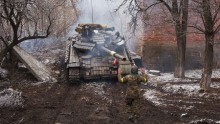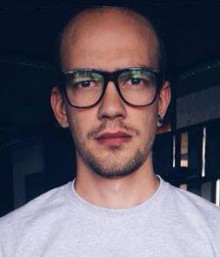When a volunteer group raised money for his two next trips by posting a photo on Facebook, Serhii Morhunov started to see photography as his way to help other people. He shared with The Day his new human and professional experience he had got in the ATO area.
You were an advertiser before; how have you come to enter the military photography field?
“I have basically stayed in advertising. As for military photography, it was an accident. I started taking pictures during the Euromaidan, then tried to figure out what was happening in Crimea, then these momentous developments in the Donbas came, and I traveled there out of curiosity at first, just to cover them... As a blogger, I tried to understand and share the information with a select number of my friends who were also interested in understanding, being aware of the events. Actually, they were my project’s initial target audience. However, even before the Euromaidan, I did reports on illegal real estate developments or some municipal initiatives as a citizen reporter. I covered such subjects, feeling it was my civic duty.”
In your opinion, are the Ukrainian media providing enough accurate information about the ATO, or are they still offering the coverage that their owners would like to see?
“It is not total, but it is the second option generally. Often enough, it is due to the incompetence of journalists, although I do not want to offend them. I would like to offer a personal example. When the battle for the airport was ending in January and early February, it happened so that I went to the east at the same time. When we entered Donetsk region, I read the news, Facebook, and everyone was saying that our poor guys should prepare for a hard night, that there was horrific fighting there. When I came directly to the airport area, though, it turned out that these events had happened three days ago. Still, no one was even embarrassed by inadequate information they provided. I know of many such occasions. For example, frankly speaking, there were virtually no Ukrainian journalists in Crimea during its annexation. Nobody knew anything, and all the news released then were built on rumors.”
Do you see something in the Donbas which was not noticed before by the rest of the country?
“When I went directly to the Donbas, I got to know a completely new area. For example, I never saw spoil tips before. I plan to do a landscapes-only Donbas exhibition, because that land is truly beautiful. I am surprised that it has had many incredible landscapes preserved over recent years, even taking into account the war and the industry decline, there is a lot of cropland there, it is a beautiful area, which could have been reused for farming or even tourism, if not for the war... There were many resort areas there. For instance, the village of Pisky, now almost destroyed, was considered the most ecologically clean zone in the Donbas. Sloviansk, despite its wartime fame, has salt lakes and clean air. However strange it sounds, there are clean and useful locations there, like picturesque Ukrainian villages, and very many of them are 150 to 200 years old. They are very different from the villages established at the time of collectivization in the 20th century. You can find real Ukraine there, beautiful and clean. Accordingly, the locals are true Ukrainians as well. I would like to show how the Donbas looks like without war and stereotypes.”
“IT IS DIFFICULT TO LIVE BETWEEN THE TWO WORLDS”
Do you feel an inner change, the difference between war and peace, when coming back to peaceful cities?
“Yes, of course. I think that civic volunteers feel it even stronger than servicemen, because soldiers are there for certain predetermined period and then come home. Meanwhile, civic volunteers (I have been one for the past year as well, paired with Serhii Lystopad) go back and forth twice a month, or even more frequently. Indeed, it is difficult to live between the two worlds, because they are so completely opposite to each other. We joke sometimes that soon, we ourselves may need psychologist’s help.”
Do you engage in informal contacts with the subjects of your photos?
“Yes, but it is mostly with soldiers, not with locals. We often go to the same village time after time, and some people recognize us, I recognize them, communicate with them, and ask how they are doing there. Maintaining contact online and by phone is impossible, because there is no connection at all there. For example, people are living in their basements in the village of Doslidne, two kilometers from the Donetsk airport, and as everywhere in the war zone, they have no food, no shops, and no medicines. All the assistance they receive is brought by us or the military who share their rations with them. Doctors, I mean all our military field medics, help restore the destroyed homes as best as they can, if that makes sense, because after a Grad or Uragan rocket hits, which are used most commonly there, only the foundation remains standing. People do not know not only what is happening in the rest of the world or in the rest of Ukraine, they do not know what happens outside their village even. They live in the information isolation in their own little hell, frozen in these small-town developments. One day a man came to us and gave us a phone number, asking: ‘Call my sister, please, tell her I am alive.’ You see, they cannot even call their family to say they are still there. As a result, we called his two sisters, one was in Donetsk, the second in the government-held territory, and they are asking us to look into evacuating him out of that zone.”
How do people react to you photographing them?
“It depends. Before every session, I explain that we have brought food, and I take photos to show the people who give us money that there are people still there, so that people in Ukraine and the rest of the world know who you are and how you live. They react calmly then, and some even pose for the camera. However, when asking permission to take photos without all these preliminaries, the answer is ‘no.’ When they are given a choice, they just say ‘no’ and then start thinking that ‘yes’ was an option as well. They are very reserved, they are afraid and feel the need to get some permission. They fear that someone will scold them for it. It is later, when they understand that they are free, they have a choice, they can do everything and no one will be scolding them, the more so that there is nobody in the position of authority to scold them there – then, they begin to tell their stories. Clearly, there is a responsibility when you take pictures of certain people in certain places. One must understand that this person can suffer because their photos will be released. To speak frankly, it is because not only ‘the Internet couch warriors’ spend time online, but enemy soldiers, too. They look at our photos, determine where they were taken, and then some piece of metal may come flying to that location.”
“EVERY PHOTO IS PART OF MY PERSONAL HISTORY”
Do you have your own rules on recording war?
“One’s photos are a manifestation of one’s soul, one’s vision. Even when recording something, one takes their own view of it, and it is transferred to the photos then. There are ethics, generally accepted standards of photography. I treasure every photo, they are all elements of my experience, I mean my human experience, not that of a photographer. It is part of my own personal experience history, because I let them all in my soul. On some occasions, I was taking pictures of people and realized that I could not keep doing it then, because I felt so strongly, so uneasy about it. Every photo has mostly emotional meaning for me. Every photo is part of my personal story. When I tell stories, I tell them as they happened.”









